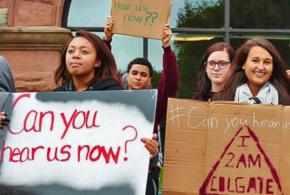Colgate protesters face racist threats
, and report from Colgate University on the administration's inadequate response to threats of violence against activists.
MORE THAN 20 students have left the campus of Colgate University out of fear of anonymous racist threats of violence, while 30 other students have organized a sit-in to protest the administration's inadequate response.
Now, as a fall semester marked by an eruption of anti-racist protest comes to a close, activism at Colgate is at a crossroads.
Crucially, among those who felt so unsafe on campus that they have left are leaders of a a weeklong sit-in that challenged the campus' culture of complacency and apathy earlier this semester.
The sit-in, whose #canyouhearusnow hashtag went viral, involved hundreds of students and cast a spotlight on the culture of racism and discrimination on campus, highlighting not only administrative and curriculum issues, but also the daily humiliations that students of color face on this elite, mostly white campus.
Following the sit-in, activism on this typically quiet campus mushroomed, with several groups and grouplets mobilized around a range of causes, from sexual assault and rape culture to Palestine solidarity. Dozens of students and faculty engaged in various forums, discussions and protests over the following weeks and months. People who had been at Colgate for several years marveled at the changing political climate on campus.

The recent grand jury decisions in the Mike Brown and Eric Garner cases came like a punch in the gut for campus activists, as they did for people around the country. Following the Ferguson announcement, a protest on the main quad was quickly organized. It drew about 50 students and faculty who chanted, "Hands up, don't shoot!" and "Black lives matter," and took turns speaking out about racism and police violence.
After hearing of the Eric Garner decision, a similar number staged a die-in at one of the campus cafeterias. All over campus that day, one could see "Black lives matter" and "We can't breathe" written on windows and doors of various buildings.
THE NEXT day, on December 4, a racist backlash began gaining steam on Yik Yak, a social networking site that allows users to post anonymously. Statements condemning "vandalism," belittling the significance of police racism and attacking the protesters appeared on the site.
While a backlash of some sort might have been anticipated, none were prepared for the virulence of the attacks. More than one post threatened physical violence against the activists. At least one post explicitly targeted activist Melissa Melendez, threatening to "bash [her] head in" and saying that she "deserved to die," after she had posted a picture of herself holding an upside-down American flag with anti-racist slogans written on it. (No screenshot of this post has surfaced, although many saw it when it first appeared.)
Emotionally distraught and fearing for their safety, students met with campus administrators, asking at first that the university be shut down. That evening, an e-mail to the faculty from senior administrators acknowledged that "vulgar and violent statements against specific protesters" had been made on Yik Yak.
Expressing concern for the students, the e-mail went on to recommend campus resources such as the Chaplaincy and Counseling Center, but made no reference to any action to investigate the "violent statements" or protect the "specific protesters."
An e-mail from the president the following day promised that the threats would be "vigorously investigated and adjudicated through Colgate's conduct process and outside law enforcement."
But the administration offered no timeframe for this investigation, and some are said to have encouraged students who didn't feel safe to leave campus. No doubt some students might have wanted to leave of their own accord, but administrators seem to have done little to reassure them that their safety would be a priority.
On the contrary, several students say they had a frightening encounter with Hamilton police at the main progressive student residence hall--known as Bunche House or Social Justice House--the following evening. A Black student was in distress and--lacking a Black chaplain or counselor who might have understood the student's distress better and offered appropriate guidance--university officials called in the local police, whose arrival and rough behavior only further traumatized the students.
That Monday evening, 21 students left campus, while 30 others staged a sit-in at the Provost's office, demanding a swift investigation of the death threats, and disciplinary and legal proceedings against those who issued them. In response, the administration informed the campus community that an investigation had been launched. As of this writing, one week after Melendez received the death threats, there has been little progress on this front and even less transparency.
The university instead sponsored a candlelight vigil for "reconciliation" on December 11, which many recognized as a stage-managed public relations stunt. The event begged the question: With several Black students having fled campus out fear of racist attacks, what does "reconciliation" mean?
The sudden departure of key leaders is a setback for activism at Colgate, but there are others who have stepped up and are continuing the struggle for racial justice. The racist backlash may have succeeded in momentarily disorienting the movement, but the struggle will continue.


